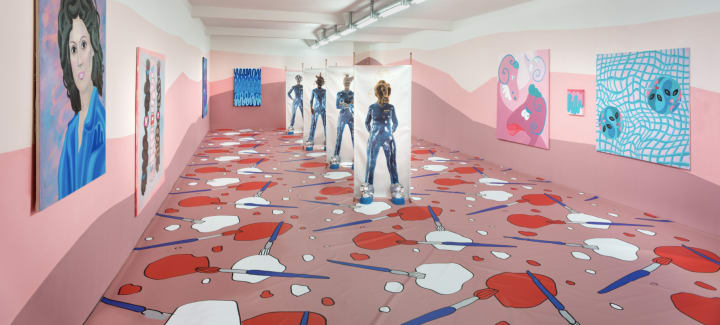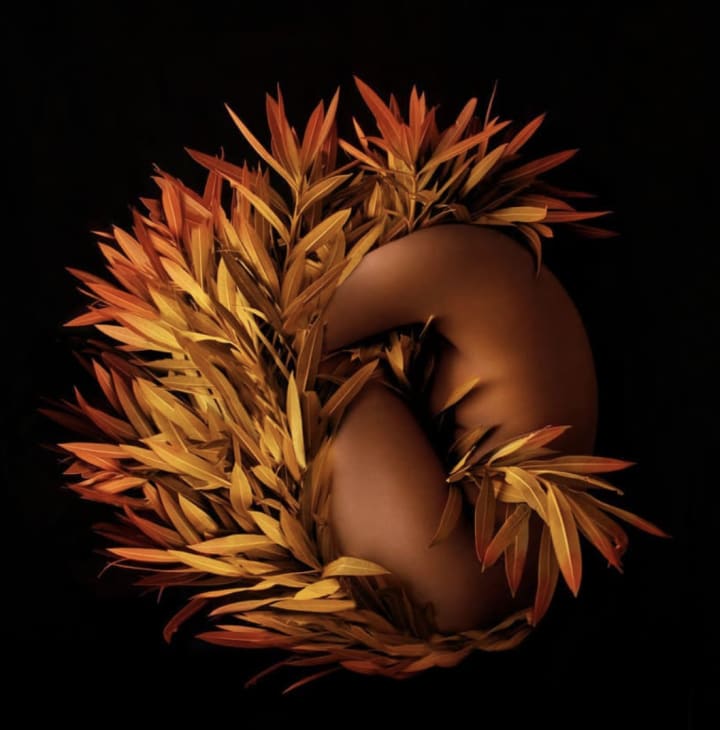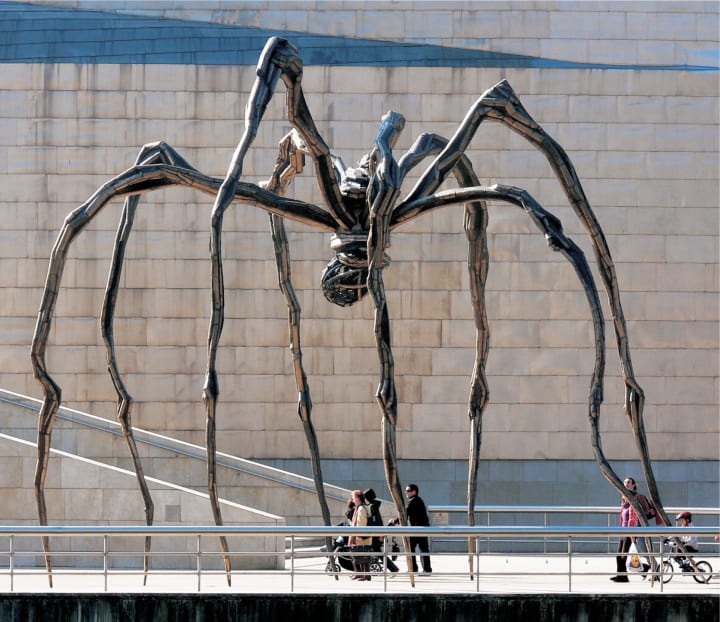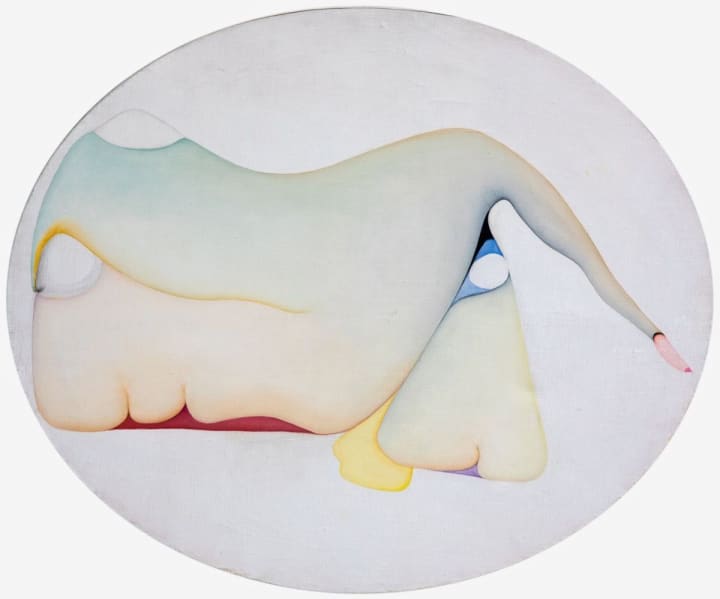Pro-femininity Feminism in Art
A Virtual Exhibition of Modern and Contemporary Art

To prove that women have the same worthiness as men, assimilation has frequently been the easiest course of action in the fight for feminism. This is why we now have things like pantsuits — due to the argument that women can be just like men. Some of the achievements that hae come out of this have been quite beneficial and/or necessary for progress, but unfortunately it has also led to a frequently subconscious, popular belief that masculine traits are the ideal. In the process of proving women have the same abilities as men, "feminine" remained what-not-to-be. Most problematically, femininity is often acknowledged as weak while masculinity is strong; the word "feminine" is still treated as an insult. This collection of artworks I've virtually curated has two main goals regarding femininity from a feminist, pro-femininity perspective: to acknowledge femininity as equal to masculinity, and to develop an understanding of femininity as a set of qualities nonsynonymous with the female gender. Visual feminine traits I will focus on include the color pink, light palettes, flower symbolism, decoration, and a less nameable yet very identifiable sense of elegance.
Firstly we must acknowledge femininity as equal to masculinity. Pieces like Marianne Vlaschits' A Disturbance Traveling Through a Medium, Lee Krasner's Icarus, or Georgia O'Keefe's Red Canna start by pointing out biases we as a society have against feminine-labeled things. For example, the color pink developed a negative bias when it was gendered as female. Actually, prior to the 1940s, pink was more commonly assocaited with males, as its origin color is red (a very aggressive color associated with masculinity). By using pink — a color now symbolic of females — in its original tone of strength, artists like Vlaschits and Krasner point out the sexist absurdity of pink's connotations of naivety. Other artists embrace the idea of femininity as quiet, yet disagree with the assumption that quiet can't mean strong. With works like Fares Micue's Like a Phoenix, Louise Bourgeois' Maman, Annie Leibovitz' Misty Copeland, and Berthe Morisot's The Psyche Mirror, we can start to see feminity as special and valuable, possible more so that masculinity. In these artworks, we see femininity as the aesthetic of inner strength. Though less flashy, the silent, emotional strength of femininity is just as if not more necessary than brute strength associated with masculinity.
The second important takeaway from this "exhibition" is an understanding of femininity as a set of qualities, not as synonymous with the female gender. The great majority of these works explore the feminine aesthetic, but pieces like Amy Sherald's Try on Dreams Until I Find the One That Fits Me, They All Fit Me and Alice Neel's Pregnant Nude prove that male portraiture can be feminine, and female portraiture can be masculine.
With these two thoughts in mind — that femininity is an aesthetic equal to masculinity and not necessarily attached to the female gender — the battle of the sexes would become inconsequential. If femininity and masculinity are equally valued, it wouldn't really matter which qualities you identify with or choose to pursue having, since your choice would not affect your standing in society. Viewing these words as unfixed adjectives would therefore not only benefit a feminist, but would significantly loosen the universal gender binaries.
Without further ado... let's look at some artworks...

Vlaschits' Berlin installation depicts a dystopian matriarchal society. Vlaschits addresses a hypothetical scenario in which women were the first to travel to space, and in the New Cosmos built a system in which women hold the primary power. Accomonying the installation is a fragment of a short story, describing a solo female commander's typical morning in her spaceship travelling to Mars. Obviously, this artist is stating female's phsyical and intellectual capability, but her approach is more unique than that; by paring this story of dominance with a cotton-candy pink palette (very associated with femininity), Vlaschits shows us that conveying a theme of power does not mean having to resort to masculine aesthetics.

In the 1960s, Krasner faced extremely sexist reception of her work as an abstract expressionist painter; while the chaotic textures in her male colleagues' work (including her husband's, the well-known Jackson Pollock's) were celebrated as displays of new, adventurous, and uniquely-American art, Krasner's work was interpreted as overly emotional and indulgent because of negative stereotypes about her gender. Therefore, honoring her work now is very important. In Icarus, Krasner uses the aforementioned pink palette associated with femininity, but in extremely vibrant tones. The rapid brushstrokes along with the chosen colors expresses femininity as loud and dynamic — thus debunking the assumption that being a feminine woman means being quiet and complicit.

Flowers have long since been connected to femininity for many reasons (one of which being their frequent visual similarity to vaginas). Historically, male voices have interpreted this analogy to mean that women are fragile and weak, much like petals can wilt upon touch. However, this perspective conventiently disregards the most important aspect of flowers: their ability to grow and be a truly beautiful part of nature. O'Keeffe portrays flowers as worthy of our respect, partially through the vibrant, warm palette seen in Red Canna but mostly through scale. O'Keeffe, through her close-up, large paintings, gave these flowers massive presence; they take up space, and they impose upon the viewer, thus reappropriating the flower symbol of women and the feminine to be the opposite of weak.

Ana Mendieta's image from Yagul highlights nature as a central aspect of femininity. Mendieta was taken from her home and parents in Cuba as a child to escape Fidel Castro's dictatorship, and thus was left with a longing for a homeland and mother. Mendieta came to see earth as the spiritual thread connecting all human beings, and Mother Earth as the ultimate mother. In her earth-body works (documented via photography), she embeds her body in the nature of a specific location. In Yagul, flowers (once again, a symbol of femininity) are coming out of Mendieta, referencing a more essentialist view of both feminism and femininity: life-creating properties. Mendieta's pose is also reminiscent of goddess iconography — a further connection to her spiritual roots as female.

Klimt's Tree of Life references the life-giving properties of female and nature, but more subtly Klimt's style promotes femininity as a valuable trait. The idea of decoration has long since been associated with the feminine realm, especially because of its presence in textiles (domestic crafts traditionally done by females). But decorate has a negative connotation as being merely excessive and distracting "fluff." However, male artists in Modern Art movements like Fauvism or Art Nouveau saw the value of decoration for decoration's sake -- using it to express powerful emotions and spark visual pleasure. Klimt's use of extreme decoration in his Gold Period elevates the decorative (feminine) style as equal to the level of fine art (especially by using a material as valuable as gold).

Fares Micue is a contemporary self-portrait photographer who frequently uses florals in her work. Micue, by embedding her own body with nature, embraces flowers as symbolic of real-world femininity. The title of this piece, Like a Phoenix, emphasizes both nature's and women's ability to "regrow" when struck down. Yes, Micue is posed in a fetal position, but you can tell by the flowers protruding out of her that what didn't kill her made her stronger. This piece, in it's somewhat minimalist composition, portrays the quiet elegance of femininity often unfairly labeled "not feminist," while in fact it celebrates internal rather than external strength. You do not always need to be loud to be strong, and sometimes the loudest voices are actually the weakest.

Bourgeois' massive spider sculptures (titled Maman, which is a familiar term for "mother" in French), were made as references to her own mother. Much of Bourgeois' work has to do with her psyche and concepts of family, as she had a difficult childhood, and felt a particular fondness for her loving mother. Her mother was a professional weaver (which has an obvious connection to spiders), but Bourgeois argues that mothers universally are much like spiders. Spiders are repairers (constantly fixing their webs) and they ensure safety by killing mosquitos (insects that spread disease). Spiders, while physically delicate, are very helpful, protective, and nurturing; this is emphasized by Bourgeois' depiction of a spider's strong, steel, cage-like body which daintily rests on slender pointed legs. This symbolism of spiders and her depiction of simultaneous vulnerability and strength makes viewers consider the mother role in a new, respectful way.

Annie Leibovitz' series Women (1999) captured the dynamic, unique personalities of prominent women leading the way to gender equality. In 2016, she published a continuation of the series entitled Women: New Portraits, which shifted the focus from what they look like to what they do. Misty Copeland, the first African American prima ballerina in the American Ballet Theater, is a particularly excellent example of Leibovitz revealing women's internal strength. The dichotomy of the flowing fabric and Copeland's clearly muscular build veiled underneath quite literally embodies the concept of inner strength. While a forceful wind blows back her hair and dress, Copeland stands determined upright, facing forward (and on point, making her endurance all the more impressive); this image pictures both female and African American stability holding strong despite the many obstacles thrown their way.

Berthe Morisot was a female impressionist painter who often made small scale works in light palettes and brushstrokes. This airy aesthetic paired with an interior, domestic scene of a woman in a dress makes this painting rather symbolic of 1800s femininity. Morisot did not believe this embracing of femininity made her paintings any less worthy than her male peers'; she enjoyed the feminine aesthetic, and did not sacrifice it in an attempt to be more respected by men. Additionally, including a mirror (and specifically titling it a "psyche mirror") implies there is much more going on in the woman's mind than what you can see. The beautiful, quiet, almost secretive interiority in this scene portrays femininity as intriguing and deep, rather than surface level and merely decorative.

Amy Sherald (made famous for her portrait of Michelle Obama) paints exclusively Black subjects, and is known for using grayscale skin tones and bright, solid colors as backgrounds. In this piece, Sherlad uses many of the previously mentioned tools to depict femininity — flowers, a soft palette, and a bright pink — but utilizes them in a portrait of a man. In this way, Sherald proves that femininity is not synonymous with female; femininity is an aesthetic, and female is a gender. For too long, femininity has been used near exclusively in a female context. Here, Sherald directly challenges that.

Unlike other works in this "exhibition", this work by Alice Neel does not contain the classic feminine aesthetics previously dissected. Neel (similarly to Sherald) proves that "female" and "femininity" are not the same thing, though Neel does this by portraying a female in a not-particularly-feminine way. Neel's brushstrokes are rough, heavy, and occasionally muddy or gorey — the paint is thick and carries weight on the canvas, unlike the airy appearance of Morisot's work. However, Neel is depicting a pregnant woman — a form that is distinctly "female." Neel illustrates the feminist message that even without femininity, you can still be very much a woman, and thus that the role of "woman" is unrestricted.

This work combines a feminine style of soft, light colors with the subject of the female body. This smooth fleshiness of the abstracted form makes this piece erotic, but it looks very different from the typical depictions of the female body you see that were made by men, for the straight white male gaze; by using a feminine aesthetic (and with the knowledge it was painted by a female artist) Caland conveys this piece was not made for men. This may also be why it is exemplary of feminist body positivity. Caland was open about the fact that she did not like her body for a significantly long time, but ehre the depiction of a female form other than an hourglass shape, depicted erotically, promotes all female body types.
About the Creator
Lili Price
Lili is an artist/photographer based in San Francisco and NYC, studying at the Parsons School of Design. She teaches Modern Art history with an emphasis on female artists, and is an art college application advisor.
lilipriceportfolio.com






Comments
There are no comments for this story
Be the first to respond and start the conversation.